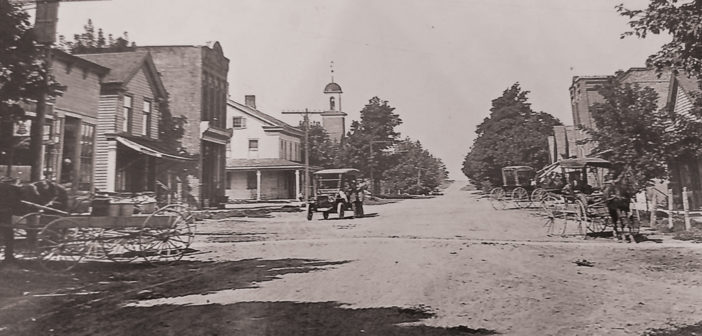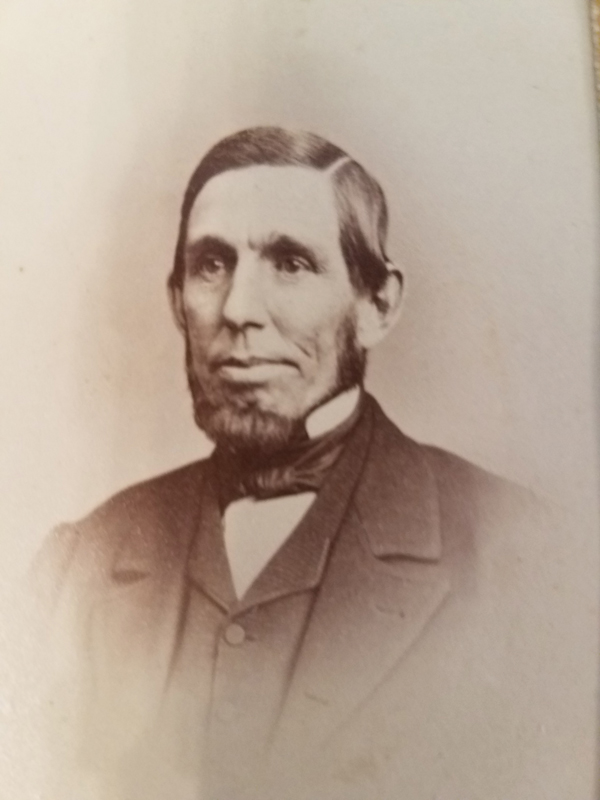Goodrich Settled: 1835
In the early 1830s, the Goodrich brothers, Moses and Enos, were living a good life in Clarence, New York but they dreamed of building a new life in a new place. They heard tales of beautiful, fertile land in the undiscovered area surrounded by the Great Lakes called Michigan. They spoke with their father Levi, supervisor of the town of Clarence, wished him and the rest of the family well and set off on their adventure. They landed in Genesee County in 1835 and found that the stories were true. The rivers were flowing and the well-lumbered land was perfect for crops. The brothers purchased 1,000 acres on which they built a log cabin and after staying for a time surveying their land, realized that they had found the best place for the Goodrich family. They traveled back to New York and in February of 1836, returned to build their legacy.
The Early Pioneers
In 1830, two brothers, Pearson and Asa Farrar, journeyed to Genesee County from Monroe County, NY. Pearson settled in Grand Blanc and Asa became the first settler in the area now known as Atlas. Asa built a log cabin and started a family; the first birth and marriages in the township belonged to the Farrar family. The next settler was Judge Norman Davison from Livingston County, NY. He built the first mill in 1833, followed by a grist mill in 1836. He dubbed the new land Davisonville. The first Davisonville Township meeting was held at Davison’s mills where the post office was established with Judge Davison as active postmaster. The Township was known as Davisonville until 1854 when the named was changed to “Atlas” due to confusion with the mail between the post office and the Davison Station on the Grand Trunk Railroad.
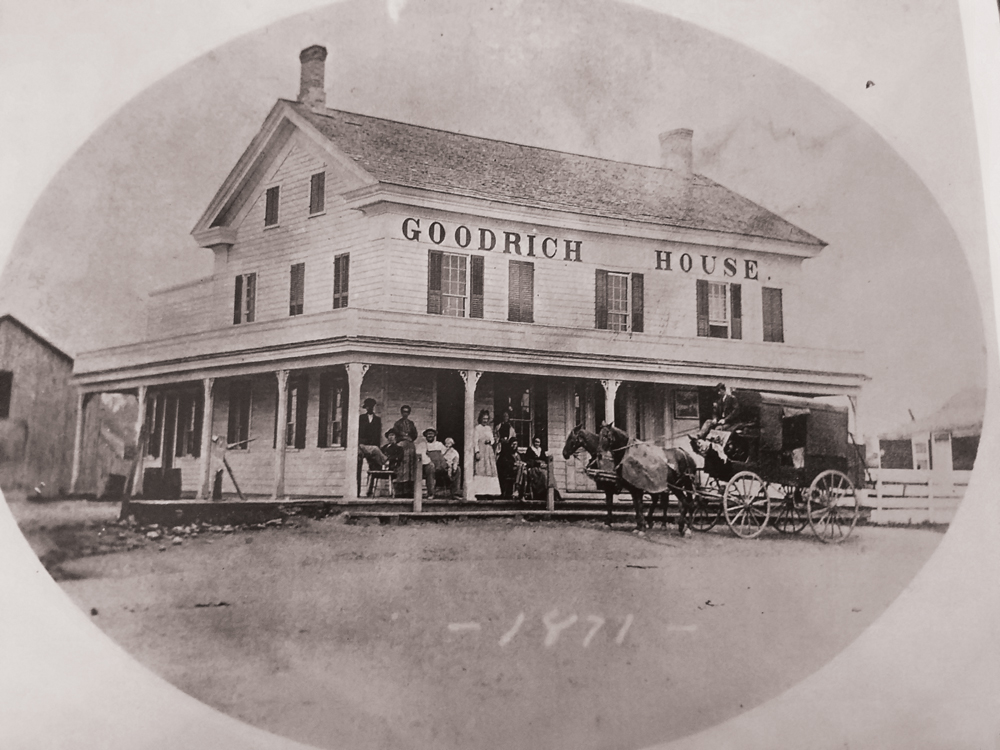
Constructed in 1846, the Goodrich House fed many a weary traveler.
Judge Davison was a prominent figure in local and state politics. In 1835, when Michigan was in the process of becoming a state of the union, Judge Davison was a member of the convention to frame the State Constitution. The Judge again played a role in State history as a delegate to negotiate the settlement of the “Toledo War,” when Michigan surrendered a portion of its south to Indiana and Ohio while gaining the Upper Peninsula.
The township grew slowly, holding few inhabitants, until the Goodrich brothers arrived in 1835 and began to construct the town of Goodrich. With them came an influx of settlers from the state of New York who were inspired by words detailing the lush, green lands of Michigan. In 1837, the first Atlas physician, Dr. Cyrus Baldwin, arrived. Soon after, the first blacksmith, Elias Rockafellow, and first merchant, Fitch Tracy, arrived and set up shop. Later that year, one of the area’s prominent citizens, Moses Wisner, came to stay. Ever active and vocal, Wisner was a harsh critic of slavery and was vehemently against the passing of the Kansas-Nebraska Act (passed in 1854, the Act allowed slavery to flourish in new states). Wisner became Governor of Michigan in 1854 and fought during the Civil War until he was stricken with typhoid fever, to which he succumbed. During this time, another prominent politician, Dr. Elbridge Gale, arrived in Atlas and became a State Senator. At the age of 16, Dr. Gale was teaching school in his home state of Massachusetts and became a doctor of notable repute. He was appointed surgeon of the provost board for the sixth district of Michigan in 1863 and held that distinction until the end of the war. Other notable persons settling in the area of Atlas during the rush of 1836-37 are Moses and Ephrain Frost, the Lobban family, the McNeil family, Ezra Paschall, the Honorable E. H. Thoruson, and Hiram Fillmore (cousin of President Fillmore). Jim Kipp arrived at the tail end of the parade and began his own little village named Kipp Corners, complete with a post office established in 1862. (The post office was removed in 1871.)

EA. Farrar and wife Lillie Shields Farrar of Atlas’ first family.
However, no other settlers left such a mark on the area as the Goodrich family. After Enos, Moses and the rest arrived in 1836, Atlas was forever changed. The family established the Goodrich Mill, multiple stores and the first wood-frame house. In 1846, Enos Goodrich became postmaster and named the village. (It would not be incorporated until the late 1950s). That same year, Enos was elected to the State legislature and argued for the State Capital to be moved from Detroit to Goodrich. His argument was so compelling that Goodrich lost the vote by only one. The most influential member of the family was Aaron Goodrich, who resided in Atlas Township for many years before moving to Tennessee and becoming a member of the State legislature. He became a president elector on the Whig ticket and in 1849, was appointed by President Taylor as Chief Justice of Minnesota. In 1860, he was a member of the Republican National Convention that resulted in the nomination of Abraham Lincoln. In 1862, he retired to Minnesota and wrote a book entitled, A History of the Character and Achievements of the So-Called Christopher Columbus, wherein he opposed the claim that Columbus was the discoverer of America. The rest of the Goodrich family farmed the lands and lived out their lives in the paradise of Atlas Township.
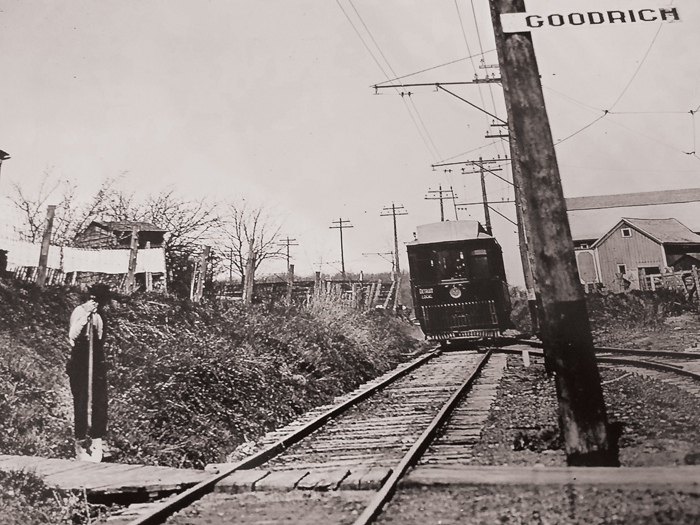
The Detroit inter-urban railway moves through Goodrich.
In the late 1830s, the male settlers of Atlas Township frequently met in an old cabin along Kearsley Creek to flaunt their mental prowess as members of the debating society. Enos Goodrich provides an account of a debating showdown between Moses Wisner and his brother, Aaron:
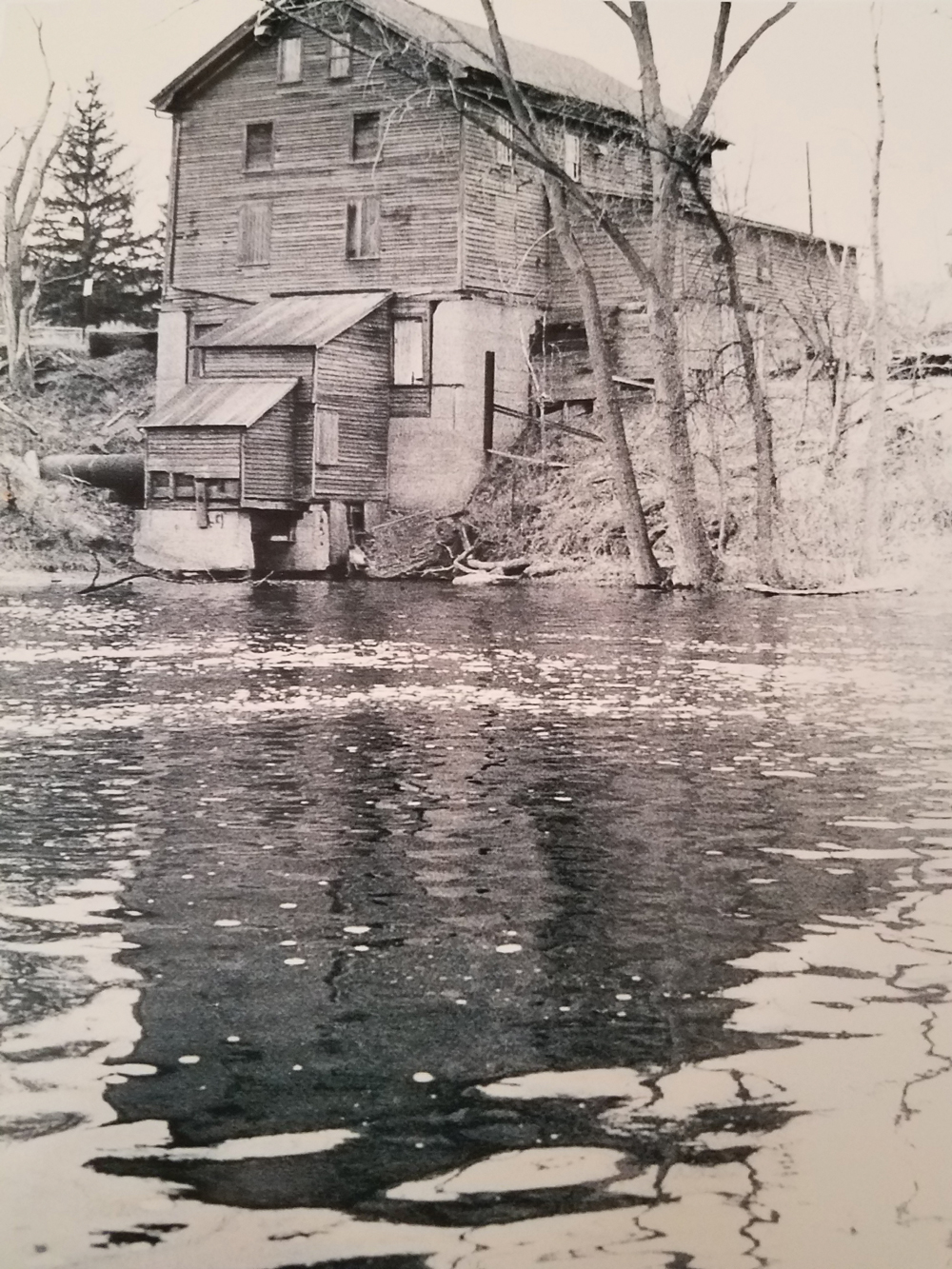
Judge Norman Davison’s original atlas mill. in 1977, the mill was moved to crossroads village and is still in operation.
“There was “Mose Wisner,” the embryo governor of Michigan, fresh from his ample library of books, and the books were well studied, for “Mose” was a most indefatigable student. Pitted against him was generally my brother, Aaron Goodrich. He never seemed to take any pains in preparation, but on hearing the argument his rapid thought was never at a loss in preparing a ready answer. He was then, as now, a rapid and original thinker. Sarcasm was always his strong hold, and, when he had discovered the weak points in his adversary’s argument, his missiles would strike like flashes of lightning, and, under his telling assaults, the carefully prepared arguments of the future-governor were knocked into a cocked hat. The result was that in nine cases out of ten the Honorable Mr. Wisner came out second best.”
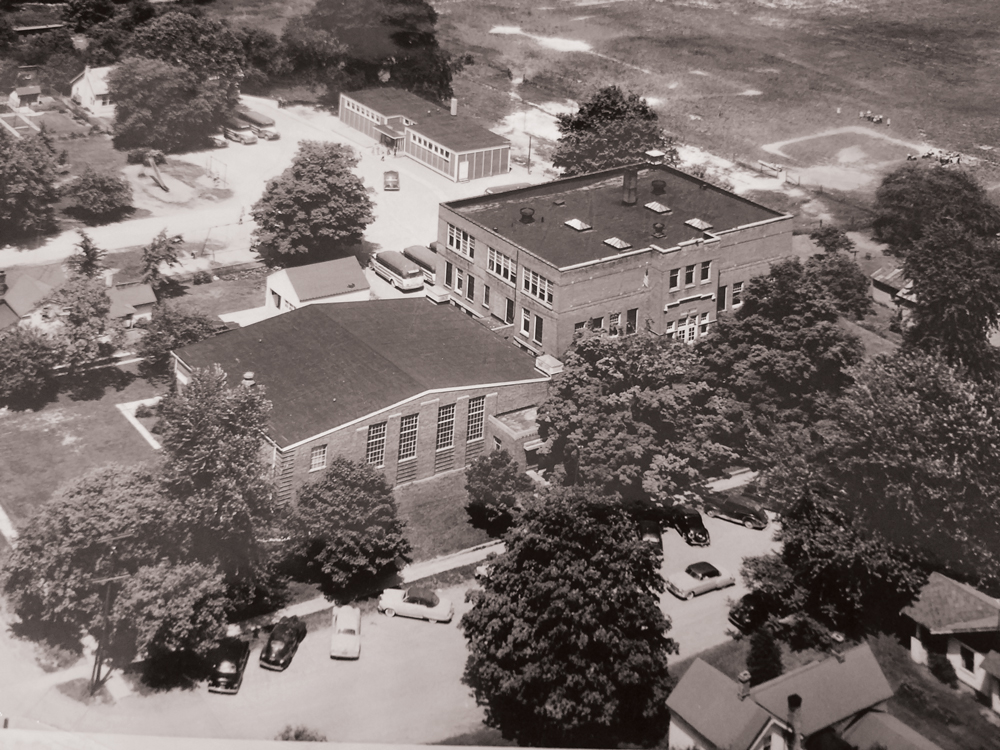
Goodrich High School, 1913.
It was at a Debating Society meeting that the idea to build a school was initiated and in 1840 the first school in Atlas Township was built. Previously, all schooling took place in a lean-to adjoining Davison’s Mill and was taught by Miss Sarah Barnes. In 1850, the school was moved to a new building constructed where the current Goodrich High School now stands.
Religion officially came to Goodrich in 1844 when the First Methodist Episcopal Church was built and was quickly followed by the Second Methodist Episcopal Church in 1849 (located in Atlas), the First Congregational Church in 1854 and the Free Will Baptist Church in 1867. In 1846, the Goodrich House was built. This fabled tavern fed many weary travelers through the years, finally meeting its end in 2012.
In 1850, an association was organized to build the Goodrich Cemetery. First interred there was blacksmith Nathaniel Fairchild, who died at 54 from lockjaw and blood poisoning caused by the prick of a horseshoe nail in his hand. In 1877, the prominent ladies of Goodrich joined forces to raise money for a village library. They formed the Goodrich Ladies Association and started the Ladies Library with just six books. Six years later, the Association purchased a new building which stood and grew until 1950 when the library was in jeopardy of closing. The Goodrich library joined the Genesee District Library system and in 1980 was moved to its current location, the former Atlas Town Hall, built in 1893.
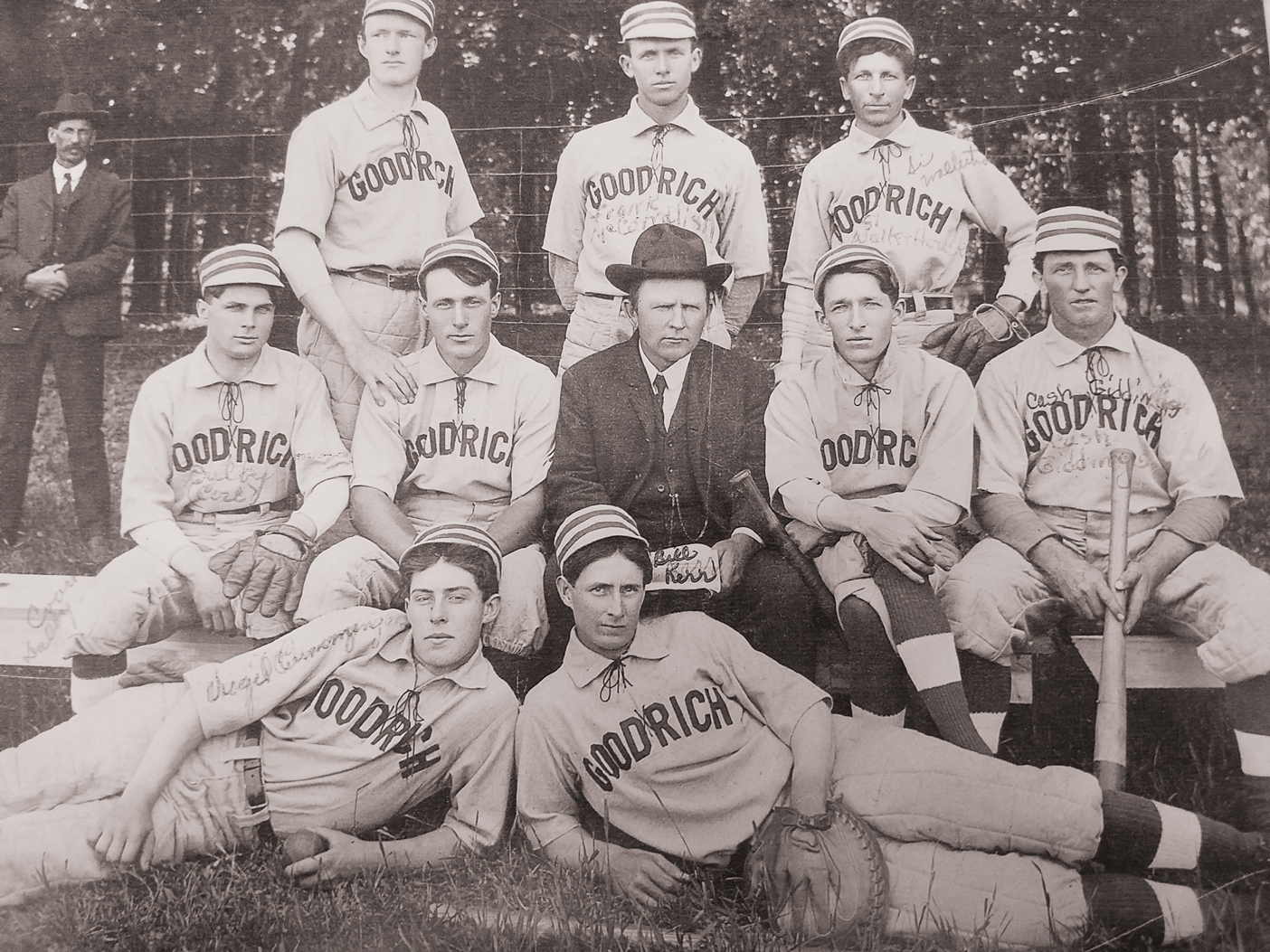
The 1904 Goodrich Baseball team. note: Cash Giddings (holding bat) was once owner of the Goodrich Mill Pond.
The Contemporary Era
In 1910, J. Dallas Dort and other prominent men from the City of Flint joined resources and purchased the Atlas farm of Mary E. Medbury. There, they constructed the Flint Golf Club (now Atlas Valley Country Club). J. Dallas Dort designed the first nine holes of the course, himself. At the time, the course was only accessible by the Detroit Inter-Urban Railway and only prominent members of society could play. (The railway is now abandoned but its banks are still visible from the eighth green.)
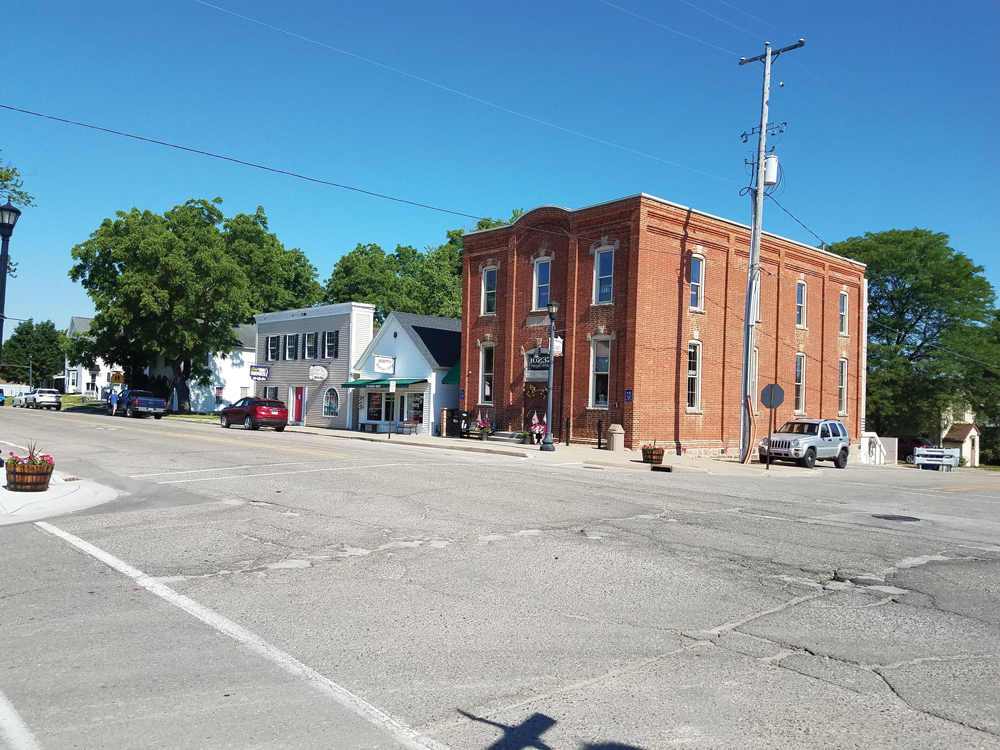
The former Atlas town hall (brick building) was built in 1893 and now houses the Goodrich Library. To the left of the hall lies the site of the original Bank of Goodrich.
In 1913, the old school house was demolished and a new one built. It was remodeled in 1923 and sits as today’s Goodrich High School, Home of the Martians. Prior to 1930, Goodrich teams were known as the Gladiators, but all of that changed when it was decided that Mars, the Roman God of War, was a more fitting mascot. (Martian, therefore, does not idolize “little green men from Mars” as many people believe.) In the 1950s, the Atlas schools were consolidated into the Goodrich School District.

Downtown Goodrich, 1910.
In the early 1890s, the esteemed Doctor of Medicine, Dr. Amos Wheelock settled in Goodrich. Dr. Wheelock then studied surgery at Ann Arbor and Chicago. Upon his return in 1909, he was named director of the Bank of Goodrich. In 1916, he returned to medicine in order to provide a better care facility for Atlas Township residents where any reputable physician could bring and care for their patients. The Wheelock Memorial Hospital was established and would operate until 2013. Also, in 1916, the Goodrich General Hospital was established. After WW2, the hospital began to struggle with unpaid bills and eventually closed its doors in 1961.
In 1919, Raymond Porter, a machinist, purchased 60 acres of land with the goal of maintaining a successful farm. Porter achieved his goal and then some. He planted his first apple trees in 1921 and Porter’s Orchard has been an Atlas Township gem ever since. In December 2008, Porter’s apple cider was voted the best in the state and afficionados from all around enjoy the cider, donuts and fresh baked goods every fall.

The Goodrich ladies library museum and Goodrich/Atlas Historical Society.
The seeds of controversy were planted in the early 1900s when the Detroit United Railway extended its electric streetcar network to Flint and built train trestles over the Goodrich Mill Pond. The train opened up even more commerce to the Village of Goodrich and local businesses prospered. In 1913, a new dam was built for the mill pond which helped the Goodrich mill continue operation. Everything was coasting along until 1927. After the electric railway system fell apart in the period leading up to the Great Depression, the owner of the Goodrich Mill Pond, Cassius Giddings, sold it to the Tarnpol family, who immediately sold it to the City of Flint, turning a tidy profit. Flint’s controversial Mayor, William McKeighan, was looking for another Flint water supply and figured the Goodrich Mill Pond would fit the bill. The City of Flint owned the mill pond without incident until Goodrich was officially incorporated in 1957.
When Goodrich offered to purchase the pond, Flint countered with a price far too high and Goodrich withdrew. Flint, however, was neglecting its property and allowing outside influences to affect the water level by controlling the dam gates. Perturbed, the Village of Goodrich sent a letter to the City of Flint asking for better oversight and requesting village control of the gates. Flint finally decided to sell or lease the mill pond to Goodrich. The price was still too steep and the village went to the Michigan Department of Natural Resources for help, but they declined. Meanwhile, Flint was taking bids from interested parties for sale of the pond. Deemed of no use with a dam badly in need of repair, the dam attracted no true buyers. Flint then planned to use the area as a landfill. Perhaps in an attempt to force the village’s hand, Flint removed the dam in May of 1970 and began draining.
A month later, Goodrich offered to buy the pond from Flint for $5,000. Flint agreed and in August, Goodrich emerged the owners. That same year, it was found that the rights to the mill pond had expired in 1861 deeming all of the sales since that time as fraudulent. It seems that Flint, most likely, never legally owned the pond. Goodrich paid $1 per share to the 12 living descendants of Levi Goodrich to legalize ownership.
In 1955, as a further effort of growth, tiny Shinanguag Lake (originally called Neshinonguac) was flooded for residential recreation. Soon, houses sprouted on its shores.
In 1977, to conserve and teach, Judge Davison’s original Atlas mill was moved to the newly-built Crossroads Village in Flint and remains in operation today as an example of pioneer life.
Today, the area of Goodrich and Atlas Township is a unique realm of beauty and calm. Its quaint and picturesque lands are a happy respite from the hustle and bustle of the rest of Genesee, while its important history continues to influence both our county and our state.
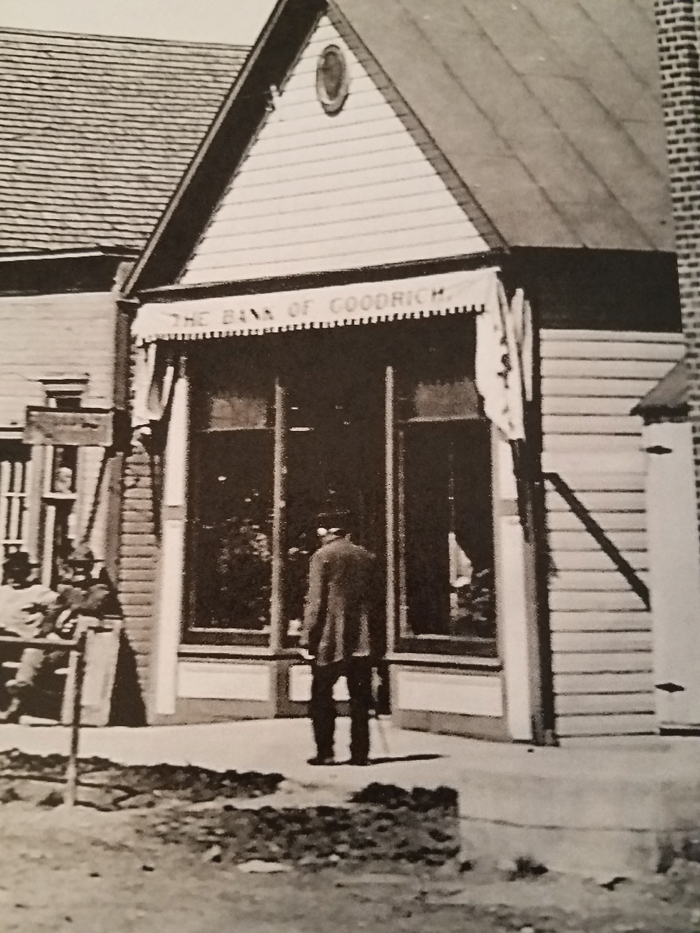
The Goodrich Bank.
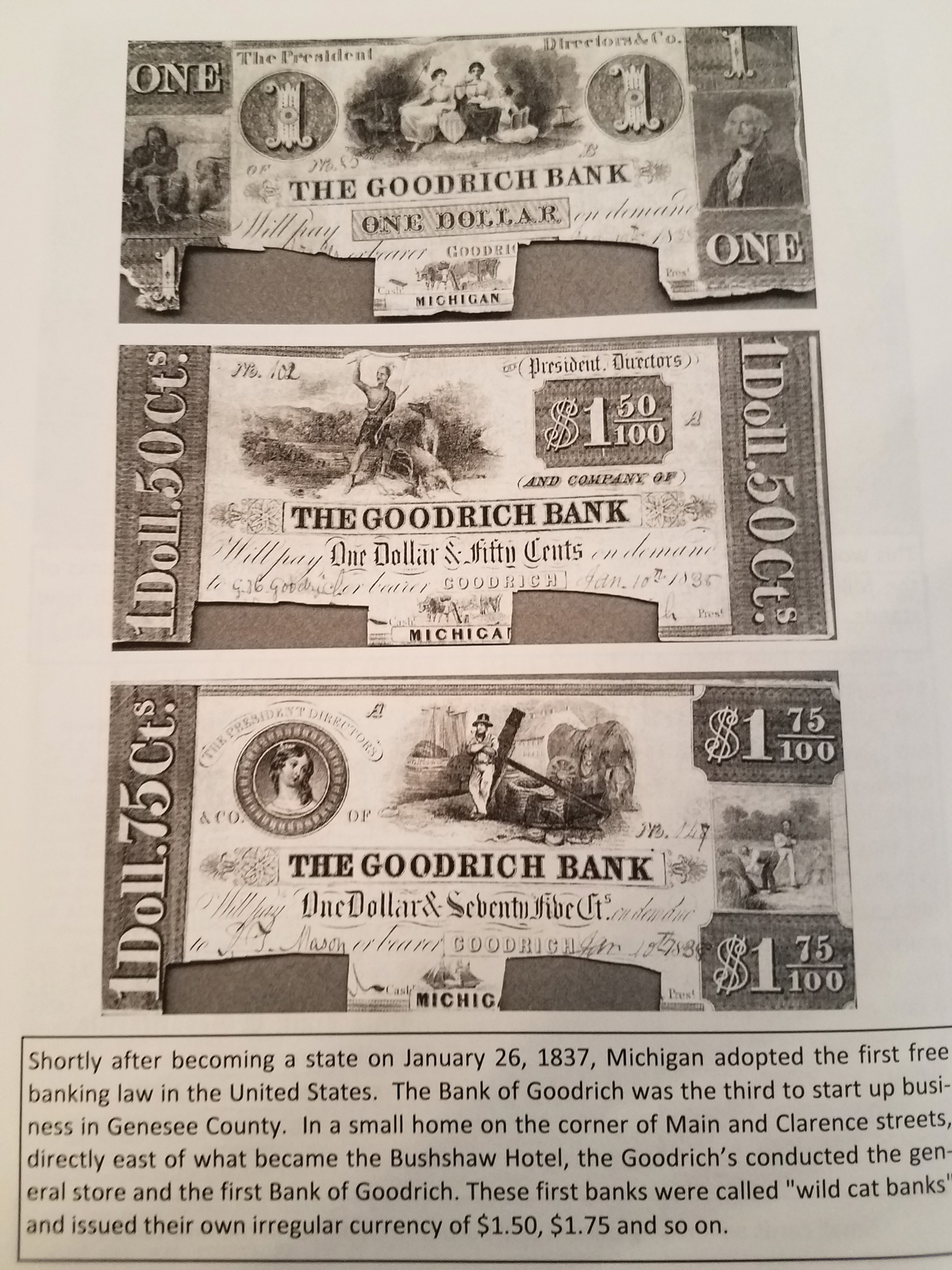
The first irregular currency offered by one of the first three “Wildcat Banks” of Genesee County.
References
Crossroads Village. (2019). Atlas Gristmill. CrossroadsVillageofflintmichigan.com. Retrieved from crossroadsvillageofflintmichigan.blogspot.com/2008/09/atlas-gristmill.html
Ellis, F. (1879). History of Genesee County Michigan. Everts & Abbott. Philadelphia, PA.
Goodrich, MI. (2015). Welcome to Goodrich. MichiganHistory.com. Retrieved from michiganhistory.leadr.msu.edu/goodrich-history-1/
Lowe, E. (2004). Past still found today in Goodrich Mill Pond. The Citizen. Retrieved from thecitizenonline.com/past-still-found-today-in-goodrich-mill-pond/
Michigan Pioneer Society. (1908). Historical Collections. Wynkoop Hallenbeck Crawford Co. Lansing, MI.
Wood, E. (1916). History of Genesee County Michigan. Federal Publishing Company. Indianapolis, IN.

